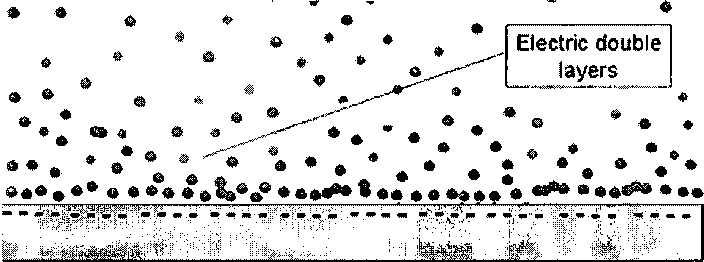1.6 Electrostatic double layer force and charge regulation
The electrostatic double-layer force arises because of surface charges at interfaces. Water
in particular has a high dielectric constant. Thus, surface charges dissociation into the
water is very common. The surface charge is balanced by dissolved counterions which
are attracted back towards the surface by the electric field. These are not reabsorbed but,
instead, form a diffuse cloud close to the surface. Taken together the ions and charged
surface are known as the electric double layer. When another surface approaches, the
double layer is perturbed, and the results in a force known as the double-layer force.
When the approaching surface charges have the same sign, the concentration of ions
between the surfaces always increases. This results in a repulsive force [21]. The
electrostatic double-layer force can be calculated using continuum theory based on work
by Gouy, Chapman, Debye, and Huckel for electric double layers.

Figure 1.10: Schematic of the diffuse electric double layer formed over a negatively
charged surface. The red dots represent positive counterions. The density of the
counterions close to the surface is higher than in the bulk. This cloud of positive
counterions is the diffuse electric double layer.
AFM tips made of silicon nitride are commonly used in studies of biological samples in
fluid and we have used such tips in our work. The surface chemistry of silicon nitride is
11
More intriguing information
1. The name is absent2. The Impact of Cognitive versus Affective Aspects on Consumer Usage of Financial Service Delivery Channels
3. On the Existence of the Moments of the Asymptotic Trace Statistic
4. THE CHANGING STRUCTURE OF AGRICULTURE
5. Searching Threshold Inflation for India
6. Review of “The Hesitant Hand: Taming Self-Interest in the History of Economic Ideas”
7. The Institutional Determinants of Bilateral Trade Patterns
8. The name is absent
9. CONSUMER PERCEPTION ON ALTERNATIVE POULTRY
10. Gianluigi Zenti, President, Academia Barilla SpA - The Changing Consumer: Demanding but Predictable